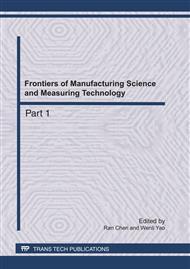p.1099
p.1104
p.1110
p.1114
p.1119
p.1123
p.1129
p.1133
p.1141
Production of a Novel Biopolymer by Culture of Bacillus cereus B-11 Using Molasses Wastewater and its Use for Dye Removal
Abstract:
The optimal conditions of production of biopolymer by the culture of Bacillus cereus B-11 were examined, using molasses wastewater to replace glucose as carbon source and energy source in the culture medium. Results showed that the COD concentration in molasses wastewater favorable for the production of the biopolymer was 5000 mg•L-1, and inoculum size of 5%(v/v), 28◦C, initial pH 7.0 and shaking speed of 150 r•min-1, under the optimal culture conditions, the highest flocculating activity achieved for Kaolin suspension was 98.5% and 3.55 g biopolymer /L broth was obtained. The biopolymer was effective in flocculating some soluble reactive dyes in aqueous solution, reactive Light-Yellow K-4G and reactive Turquoise Blue KN-G with a decolorization efficiency of 97.5 and 94.7%, respectively,using 25 mL of the flocculant in 500 mL of 100 mg•L-1 dye solution.
Info:
Periodical:
Pages:
1119-1122
Citation:
Online since:
May 2011
Authors:
Price:
Сopyright:
© 2011 Trans Tech Publications Ltd. All Rights Reserved
Share:
Citation:


